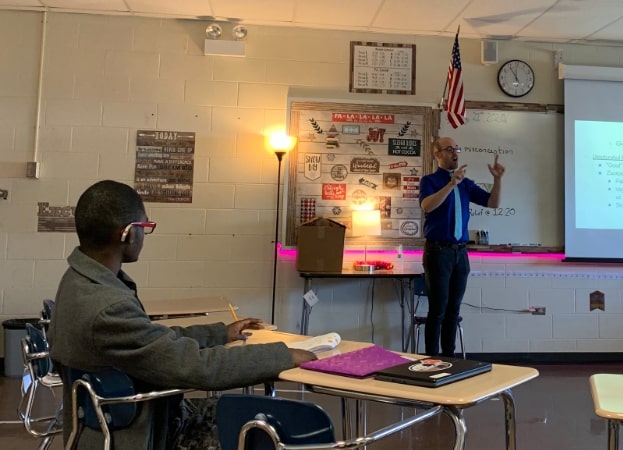Your donation will support the student journalists of Lemont High School. Your contribution will allow us to purchase equipment and cover our annual website hosting costs.
Deaf education program provides community through education
Deaf education program offers beneficial curriculum and learning opportunities to deaf and hard of hearing students.
January 27, 2020
Joe Tennerelli teaches health during B3 to five students with the assistance of two aids, Dina Kobarik and Michael Morsovillo, and an interpreter, Daina Greenberg. To start health class, Tenerelli posts a bellringer with simple questions about hygiene: How do you clean your teeth?, When should you wash your hands?, and Why do you need to wash your feet? Tennerelli said, “While these questions are very basic, the main focus is language developments – can students understand and respond to these questions.” Tennerelli explains he is opting to sign spell diet, because the sign is associated with restrictions. Student, Davan Taylor asks about diet beverages.
Since 2005, Lemont schools have provided a comprehensive deaf education program to provide students within Cook County access to both quality education, and a community of other deaf and hard of hearing (DHH) students.
The program consists of four full-time teachers, two paraprofessionals, and eight interpreters and 26 students.
The DHH education at Lemont is apart of a special education co-op, the Southwest Cook County Cooperative Association for Special Education, which means the program extends to students beyond District 210 borders. Deaf and hard of hearing students from all Cook County suburbs participate in the program; ultimately, this leads to a more diverse group full of students not only from Lemont, but other suburbs, such as Joliet, Plainfield, Bolingbrook, and Tinley Park.
“Instead of going to their home highschool, students come here to have a deaf community and speak sign language,” said Lidsney Adamson, the department chair for the deaf education program, “so, they are not the only deaf or hard of hearing student, which would’ve happened at local schools.”
In addition to offering all the core classes required for graduation, the main focus of the program is language development, said Joe Tennerelli, a deaf education teacher. Teachers instruct using sign language and speech, so students can respond directly.
If deaf or hard of hearing students grow up with a family who doesn’t sign, or without services, they lack the same opportunity to learn language incidentally through interactions at a young age. Ultimately, this leads to delayed language development, which makes the language aspect of the program so crucial.
The program is offered from elementary school to high school – furthering the sense of community and comfort. “A majority of our students have a lower reading ability, so we bring the curriculum to a lower reading level,” said Adamson.
In the classroom, teachers and aids give instruction in both American Sign Language and vocally. Students can respond through sign language or vocally as they work alongside paraprofessionals and interpreters.
Adamson explains one of the main advantages of the program is that it’s catered to the needs of each individual student. There are classes with only deaf and hard of hearing students, or self contained classrooms, for students who would not find traditional classrooms positive or beneficial. Students can also opt to take classes outside the program with an interpreter signing everything that is said.
But students can take advantage of both environments. For example, if a certain student excels in math, they can take math classes alongside hearing students, while still taking other classes in the deaf education program.
After high school, students have the option to go on to a transition school or pursue higher education in college; many dream of attending the all-deaf college Galaudet. “One thing that we look at is what a student is planning to do after school,” said Adamson.
Students receive the proper training to join the workforce or college in a transition school but leave Lemont High School with the tools necessary to achieve their goals. In this transition program, students may continue academic learning and independent learning, such as budgeting or cooking – basically anything the specific student needs to prepare them for after high school.
After 15 years in the community, the program continues to offer quality education for all students, while expanding classes and staff, incorporating new technology, and transforming the culture at Lemont schools. Recording tools on Chromebooks, such as Flipgrid or WeVideo, allow students to actually record sign language and submit responses that way. The American Sign language classes build a connection between the deaf and hearing students.
Adamson reminds us, “The main thing to keep in mind is that our students are capable of doing anything. We have kids who play football, are on the swim team, or in band. They can participate in school and be successful as anyone else.”

